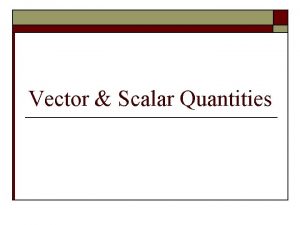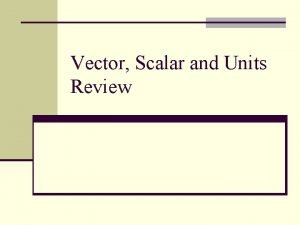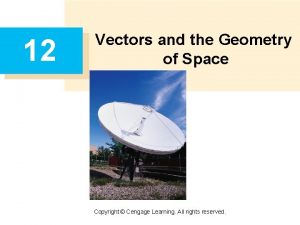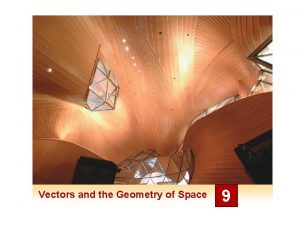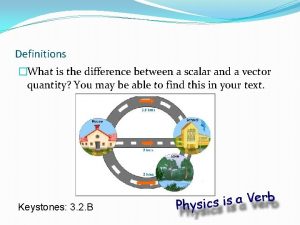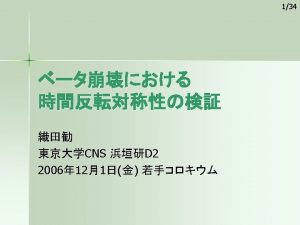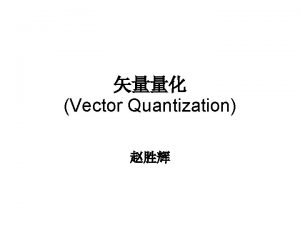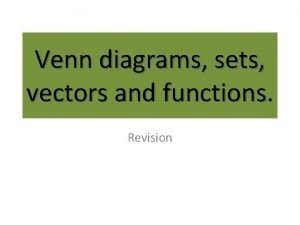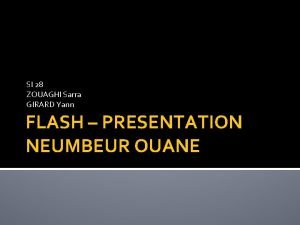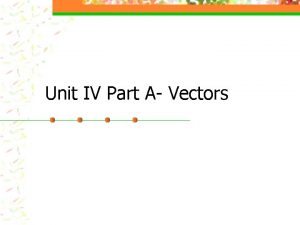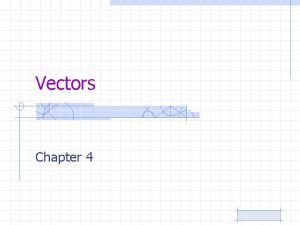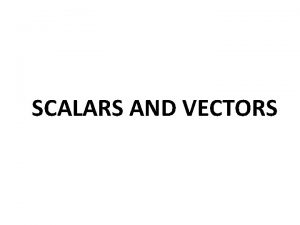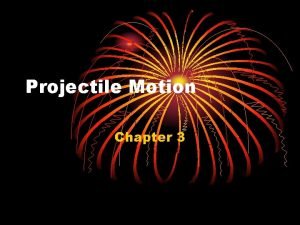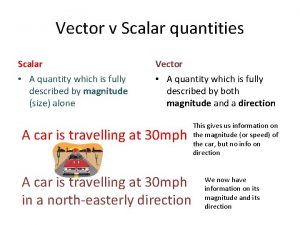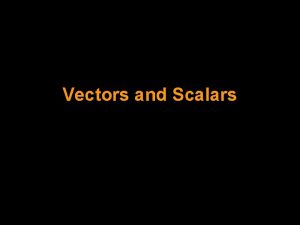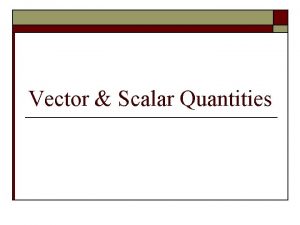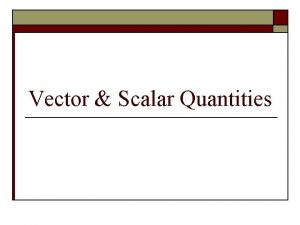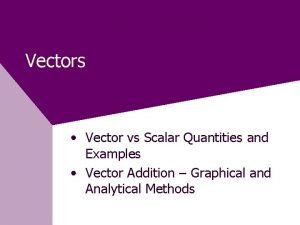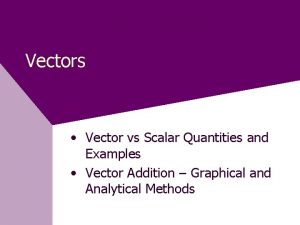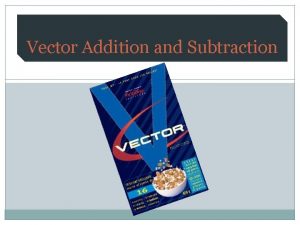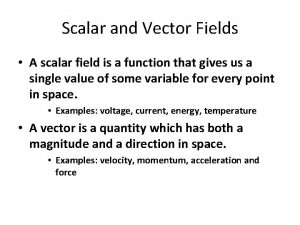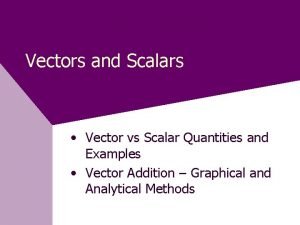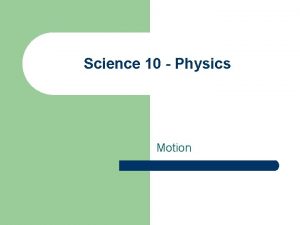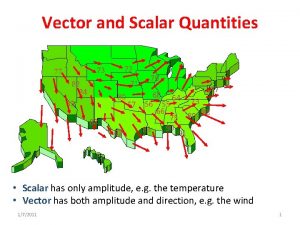Scalar and Vector Quantities AMELIA NUR SAFITRI AMEL


































- Slides: 34

Scalar and Vector Quantities AMELIA NUR SAFITRI ( AMEL )

Lesson Objectives At the end of the discussion, the students are able to : 1. Differentiate between scalar quantity and vector quantity. 2. Illustrate vector representation. 3. Distinguish between distance and displacement. 4. Objective for values or affective.

What the differences between the scalars and vectors ? Anyone can answer it ?

Try to identify which one the scalars and the vectors 1. 340 degrees celcius 6. 86 degrees Fahrenheit 2. 500 meters 7. 5 meters to the right 3. 45 meters persecond south 8. 10 kilograms 4. 330 m. L of oil 9. 30 mph north 5. 100 N east 10. 70 Joule

Scalars Vs Vectors Scalars Physical quantities Scalar quantity Vectors Description Has magnitude only Physical quantities Vector quantity Description Has magnitude and direction Mass 15 kilograms velocity 80 meters/second westward Time 30 seconds displacement 20 meters going east Energy 4, 184 Joules acceleration 500 newtons, 20◦ north of east What is the magnitude and direction ?

Magnitude Direction A magnitude represents the size or quantity of something An indication of how something is oriented in space Example of Magnitude Weight of an object Amount of money Length of a distance

Concept of Tip and Tail of Vector Length of the arrow The length of the arrow represents the magnitude of the vector The tail represents the origin Tip The tip of the arrow indicates the direction of the vector Tip Tail Lengt h of th e arro w Tail

Exercises Draw the following vectors 1. 20 meters west 5. 50 N 30° north of east 4. 80 m/s along the negative y-axis 2. 100 N east 3. 50 meters north

Vector Addition Scalar quantities may be added using simple arithmetic. Suppose a teacher walked from his house going to school and then back to his house. The illustration in figure 1 shows the path that the teacher took in his whole trip. 50 m east 40 m north School 40 m south House 50 m west • The total distance is 180 meters • The total displacement is 0 meters

Distance Displacement Distance is the lenght of the actual paths traveled Displacement is the lenght and direction of the change in position measured from the starting point. Example : 1. Calculate the distance based on the picture Start 2. Calculate the displacement based on the picture 30 meters The answer 40 meters Finish 1. 70 meters 2. 50 meters

Distance and Displacement 1. If a car travels 50 units east and then 40 units west, then what is the distance the car has traveled ? 2. If a car travels 50 units east and then 40 units west, then what is the displacement of the car ? 3. Three monkeys A, B, and C start from the same point 0. Monkey A went 3 km north, and then 4. 0 km west. Monkey B went 5 km east, and monkey C went around the circular path of diameter 2 km. Determine (a) the distance traveled by each monkey and (b) the displacement of each monkey from point 0. 4. Find the distance traveled and the displacement of the following vectors a. 40 m due north and 30 m due east b. 6 m due south, 10 m due east, and 5 m due north

Review for the last meeting 1. 2. 3. • Differences between scalar and vector • Concept of tip and tail • Distance and dispalcement

Second Meeting Triangle or tip to tail method Graphical or Geometric Method Parallelogram Method Polygon Method Next Rule : The vector sum (resultant vector) is represented by an arrow that connects the tail of the first to the head of the last after the arrows representing a set of vectors are laid tail to head in any order.

The rules of all method 1. Triangle Method 3. Polygon Method The resultant is obtained by connecting the tail of the first and the arrowhead of the last vector. 2. Parallelogram method 1. Applicable only when adding two vectors. 2. Can only be done when a suitable scale and appropriate angle are used. 3. The resultant is obtained by closing the side of a triangle formed by the two given vectors whose direction angle is measured with a protaction The resultant of two vectors acting at any angle between 0° and 180° upon a given point is equal to the diagonal of a parallelogram of which the two vectors are the side.

Back Resultant Vector 1. Triangle or tip to tail method How can we add these two vectors and draw the resultant vector ? B A A R B A R = A + B R = A - B Steps : 1. the first vector exactly the way it is 2. Take the second vector and place the tail of the second vector on the tip of the first one. 3. The result vector and draw a line from the tail of the first vector to the tip of the second one.

Let’s Do it (Individual) 1. Look at the vectors below and find the sum of (A+B), (A-B), (3 A+2 B): B A 2. Look at the vectors below and find the sum of (A + B), (2 A – 3 B ) A B

How about this one ? ? Back 2. Parallelogram Method B A We have two vectors where the tip of both vectors starts at the same point Where is the resultan vector ? R B A This called parallelogram methode Steps : 1. We have to draw another line that’s similar to vector A with the same size and vector B too. 2. Draw line from the initial point to the final point. And that’s going to give you the resultan vector

Problem 1. The diagram represents a 5. 0 N and a 12 N for acting on point P. The resultant of the two force has a magnitude of 2. To best understand how the parallelogram methode works, let’s examine the two vectors below. The vectoes have magnitudes of 17 m and 28 m and the angle between them is 66°. Our goal is to use the parallelogram method to determine the magnitude of the resultant. 17 66° 28

3. Two forces of magnitude 6 N and 10 N are inclined at an angel of 60° with each other. Calculte the magnitude of resultant.

3. Polygon Method C D D B C R B A A R = A + B + C + D Next

Sheetwork 1. Find the resultant vector of the following set of vectors: (scale: 1 cm = 1 m/s) – 5. 0 m/s, 45° + 2. 0 m/s, 180° – 6. 0 m/s, 225° + 2. 0 m/s, 90° – 8. 0 m/s, 33° + 4. 0 m/s, 45° 2. Draw and find the resultant vector of the following set of vectors: • 3. 0 m/s, 45 deg + 5. 0 m/s, 135 deg • 2. 0 m/s, 315 deg + 5. 0 m/s, 180 deg + 2. 0 m/s, 60 deg • 4. 0 m/s, 90 deg + 2. 0 m/s, 210 deg

Third Meeting Pythagorean Theorem Analytical Method Law of Cosines Component Method

1. Pythagorean Theorem B A A 2 + B 2 = C 2 + B A C A 2 + B 2 = C 2 The condition for using Pythagorean theorem to add vectors is that the two vectors must make a right angle such as North and East, North and West

Adding Vectors – Using Trig. To Determine Direction b a = side adjacent to angle θ b = side opposite to angle θ a c c = hypotenuse of triangle θ θ

Example 1. Find magnitude and direction of reasultant 10 km north and 5 km west 5 10 R θ

Problem 1. A student walks 10 m east then turns and walks 15 m north to reach his friend’s house from her place. Where is the student with respect to his house ? 2. A man drives 10 m north, and then 20 m east. What are magnitude and direction of his displacement from the starting point ?

2. Law of Cosines 5 m k 5 Cosine Law Used to find magnitude a B θ b 82 k m 120 ° Sine Law Used to find magnitude a A B θ b A

Cosine Law Used to find magnitude a θ b a A B Sin Law Used to find magnitude b θ A B R R

Example m k 5 140 ° 6 92 k m A B R

Problem 1. An insect crawls 18 ft in westward direction then runs 20 ft, north 37° west. If the insect is approximately 34 ft from the point of origin, where is it located ? 2. Vector A is 10 units and vector B which makes 60° with vector A is 20 units. Find the resultant vector.

3. Component Method 6 km Rules + 6 km 2 km 6 km Resultant + 2 km 1. Add horizontal components. 2. Add vertical components. 3. Use pythagorean theorem to find the magnitude of the resultant. 4. Use tangent function to find direction of the resultant.

Example 2 m 16 m + 16 m 36 m 24 m 2 m + 24 m + 36 m 1. Add horizontal components Rx = 52 m 2. Add vertical components Ry = 22 m 3. Use pythagorean theorem to find the magnitude of the resultant = 56 m 4. Use tangent function to find direction of the resultant = 68 °

Problem 1. Find the magnitude and direction of the resultant. 5 m 7 m 2. Find the magnitude and direction of the resultant. 7 m 12 m 7 m 5 m

Worksheet 1. A student walks 10 m east at 30° north of east, 6. 0 m northwest, and 8. 0 m west. How far has he traveled ? What is the student’s displacement ? 2. Two tugboats are towing a ship. Each exerts a force of 6 tons and the angle between the towropes is 60°. what is the resultanot force on the ship ?
 Scalar and vector quantities similarities
Scalar and vector quantities similarities Scalar quantity and vector quantity
Scalar quantity and vector quantity Distance scalar
Distance scalar Vector quantity
Vector quantity Vector v scalar
Vector v scalar Scalar versus vector quantities
Scalar versus vector quantities Ida safitri laksono
Ida safitri laksono Angular velocity to linear velocity
Angular velocity to linear velocity Addition of vectors
Addition of vectors Scalar projection vs vector projection
Scalar projection vs vector projection Find the scalar and vector projections of b onto a.
Find the scalar and vector projections of b onto a. Find the scalar and vector projections of b onto a
Find the scalar and vector projections of b onto a Scalar and vector quantity difference
Scalar and vector quantity difference Scalar vector tensor
Scalar vector tensor Scalar and vector quantization
Scalar and vector quantization Scalar and vector venn diagram
Scalar and vector venn diagram Kim kuranı kerimi okur ve onunla amel ederse arapçası
Kim kuranı kerimi okur ve onunla amel ederse arapçası Salih amelle ilgili ayetler
Salih amelle ilgili ayetler Salih amel vaaz
Salih amel vaaz Amel henider
Amel henider Amel defteri sağ taraftan verilenlere ne denir
Amel defteri sağ taraftan verilenlere ne denir Dr amel yanis
Dr amel yanis Dr amel yanis
Dr amel yanis Dr amel mrabet
Dr amel mrabet Yann zouaghi
Yann zouaghi Amel bekkouche
Amel bekkouche Amel bekkouche
Amel bekkouche Amel khairani paris
Amel khairani paris Physical quantity
Physical quantity Which of the following is a pair of vector quantities
Which of the following is a pair of vector quantities 30 examples of vector quantities
30 examples of vector quantities Vector vs scalar
Vector vs scalar Scalar vector tensor
Scalar vector tensor Entropy is scalar or vector
Entropy is scalar or vector Is projectile
Is projectile



